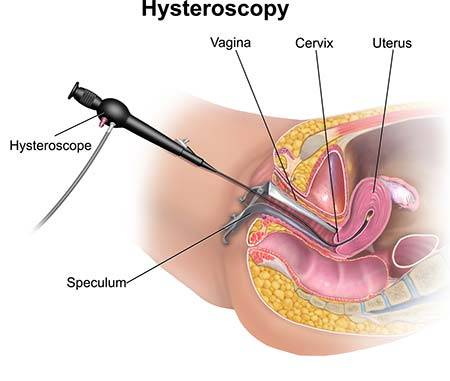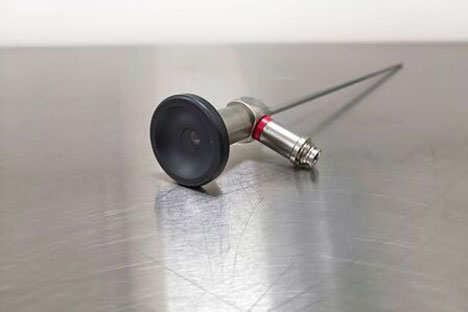Hysteroscopy
 A hysteroscope is a thin tube with a light on the end that can expand. Surgical instruments can be passed through a hysteroscope. Your OBGYN can use the device either as a diagnostic tool — that is, to aid in an examination on the way to making a diagnosis — or as a functional tool to aid in a surgical procedure. Hysteroscopy refers to any procedure, diagnostic or functional, for which your gynecologist uses a hysteroscope.
A hysteroscope is a thin tube with a light on the end that can expand. Surgical instruments can be passed through a hysteroscope. Your OBGYN can use the device either as a diagnostic tool — that is, to aid in an examination on the way to making a diagnosis — or as a functional tool to aid in a surgical procedure. Hysteroscopy refers to any procedure, diagnostic or functional, for which your gynecologist uses a hysteroscope.
While similar to a laparoscope, the hysteroscope is designed to be used inside your vagina and uterus. When your gynecologist uses a laparoscope to examine the outside of your uterus, that’s laparoscopy — hysteroscopy is when your local gynecologist in Midtown uses a hysteroscope to examine the inside of your uterus. In fact, your OBGYN can use both devices at the same time to look at the inside and the outside of your uterus and get the full picture.
Diagnostic Hysteroscopy
Hysteroscopies can be both diagnostic and therapeutic
Even with a speculum in place, your Midtown gynecologist may have a difficult time seeing all the way past your cervix into your uterus. A lighted hysteroscope makes the process easier. The camera allows image lightening and magnification. Reasons for a diagnostic hysteroscopy include:
- Abnormal bleeding, especially after menopause
- An abnormal Pap smear result
- Uterine bleeding
- Trying to diagnose infertility causes
- Diagnosing pain symptoms
Your OBGYN can use it to assist in other ob gyn procedures, as well. Because it’s so versatile, the hysteroscope has become a commonly used tool in a gynecologist’s toolbox.
Functional Hysteroscopy

Because the hysteroscope is a hollow tube, your gynecologist in Midtown NYC can pass tools through it to perform functional tasks. In fact, the two uses of a hysteroscope go hand-in-hand, as its diagnostic use can find an issue — such as endometrial polyps — and its functional use can perform the task, in this case removing the polyps (a hysteroscopy polypectomy).
Your gynecologist accomplishes this by pushing a cutting tool though the hysteroscope to remove the polyps. Other functional hysteroscopy uses include:
- Identifying and removing uterine fibroids
- Removing genital warts
- Finding and removing adhesions
- Taking a hysteroscopy biopsy
- Removing an IUD (an intrauterine device used for contraception)
- Locating the cause of abnormal bleeding and sealing it (hysteroscopy ablation)
Pros and Cons of Hysteroscopy
Every tool your gynecologist uses and every procedure done comes with some risk. Often, the healing benefits outweigh the medical risks, but your gynecologist in Midtown should explain everything that will be done to you well enough so you can weigh the pros and cons yourself. With hysteroscopy, there are substantial benefits:
- It’s a minimally invasive procedure.
- It leads to a much shorter recovery period.
- You’ll need less pain management (and fewer drugs).
- You’ll rarely if ever need a hospital stay after hysteroscopy.
- You can avoid more intensive and invasive surgery.
The risks and side effects associated with hysteroscopy are similar to other gynecological procedures:
- Introducing an infection
- Causing heavy bleeding
- Accidentally damaging your bladder, bowels, cervix or uterus
- Scarring of the endomtrium (the lining of your uterus)
- Creating unexpected problems from the gas or liquid used to expand your uterus
Furthermore, you should not have a hysteroscopy done if you’re pregnant or suffering from:
The Hysteroscopy Procedure
A hysteroscopy is almost always an outpatient procedure. Most of the procedures are performed in a specialized gynecology facility in NYC. When your OBGYN performs a hysteroscopy, both diagnostic and functional uses are both employed. Depending on the purpose and goal of the procedure you’re undergoing, you may need general anesthesia or just mild sedation with local anesthesia. Make sure you know which you will receive before you agree to the procedure so that you can make appropriate plans for your recovery once you get home. Here’s a common procedure as a sample:
- Once you’re situated, your gynecologist in Midtown dilates your cervix and then inserts the hysteroscope into your vagina, past the cervix and into your uterus.
- A gas, such as carbon dioxide, or a liquid, such as saline, is passed through the hysteroscope into your uterus to clean it out and expand it.
- The lighted end of the tool lets your doctor examine in detail inside your uterus, including where the fallopian tubes branch off.
- If a procedure needs to be done — whether a biopsy, ablation or polypectomy — your OBGYN can pass the appropriate tool through the hysteroscope to exactly where the tool is needed.
Hysteroscopies require minimal recovery, usually just one day
Your procedure can take anywhere from five minutes to an hour, depending on what you’re having done. Ask gynecologist in Midtown before the procedure to explain anything you don’t know or understand, including how long your process should take.
Recovering from Hysteroscopy
You rarely need to do anything special after a hysteroscopy since it’s so minimally invasive. Depending on the specifics of your procedure, you may experience some cramping or light bleeding for several days. You can take a mild pain reliever (except aspirin, which can increase bleeding) as needed.
Your OBGYN may advise you not to douche or have sexual intercourse for two weeks after your hysteroscopy, but you can return immediately to all your other normal daily activities without limitations. You can even eat your normal diet right after your procedure. Just remember that you may be a little gassy.
Hysteroscopy Notes
Regardless of the purpose of your hysteroscopy — even if it was a functional procedure — you should have no problems trying for a pregnancy after hysteroscopy. In fact, some fertility clinics use hysteroscopy procedures to determine the cause of infertility and correct it, if possible.
If you have severe pain, a fever, heavy bleeding, an unusual discharge or spotting after hysteroscopy, contact your gynecologist in Midtown. These are abnormal reactions to the procedure and may indicate a rare complication.
Symptoms should always be evaluated with a thorough consultation and examination by your gynecologist for an accurate diagnosis and treatment plan to exclude any underlying serious condition.
Important Reminder: This information is only intended to provide guidance, not definitive medical advice. Please consult obgyn doctor about your specific condition. Only a trained, experienced gynecologist can determine an accurate diagnosis and proper treatment.
Have questions about Hysteroscopy? Schedule an appointment with the best Midtown NYC Gynecologist, Dr. Fernando Mariz, please contact our office.
Updated on Jun 23, 2020 by Dr. Fernando Mariz (Gynecologist), Manhattan Women’s Health and Wellness
Best-in-class
New York Gynecology Clinic
Manhattan Specialty Care in the Press

Call now to make an appointment with our highly rated Manhattan Gynecology doctors regarding your health. We look forward to seeing you!
book online now
(212) 378-9987
New York City Locations:
Manhattan Women's Health & Wellness (Upper East Side)
983 Park Ave, Ste 1D17
New York, NY 10028
(212) 389-1904
Manhattan Women's Health & Wellness (Midtown)
51 East 25th St, Ste 451
New York, NY 10010
(212) 677-7654
Manhattan Women's Health & Wellness (Union Square)
55 W 17th St, Ste 104
New York, NY 10011
(212) 378-9985